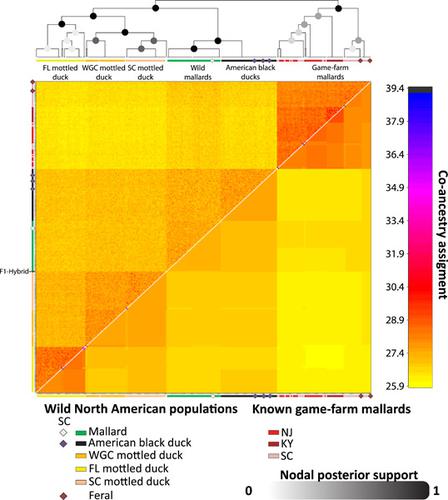当前位置:
X-MOL 学术
›
J. Wildl. Manage.
›
论文详情
Our official English website, www.x-mol.net, welcomes your
feedback! (Note: you will need to create a separate account there.)
Population Genetics of a Translocated Population of Mottled Ducks and Allies
Journal of Wildlife Management ( IF 1.9 ) Pub Date : 2021-08-25 , DOI: 10.1002/jwmg.22124 Philip Lavretsky 1 , Esmeralda Duenez 1 , Molly Kneece 2 , Richard M. Kaminski 3
Journal of Wildlife Management ( IF 1.9 ) Pub Date : 2021-08-25 , DOI: 10.1002/jwmg.22124 Philip Lavretsky 1 , Esmeralda Duenez 1 , Molly Kneece 2 , Richard M. Kaminski 3
Affiliation

|
Translocating species is an important management tool to establish or expand the range of species. Success of translocations requires an understanding of potential consequences, including whether a sufficient number of individuals were used to minimize founder effects and if interspecific hybridization poses a threat. We provide an updated and comprehensive genetic assessment of a 1970s–1980s translocation and now established mottled duck (Anas fulvigula) population in South Carolina, USA. In addition to examining the population genetics of these mottled ducks, we simulated expected genetic assignments for generational hybrids (F1–F10), permitting formal purity assignment across samples to identify true hybrids and establish hybridization rates. In addition to wild mallards (A. platyrhynchos), we tested for presence of hybrids with migrant American black ducks (A. rubripes) and released domestic game-farm mallards (A. p. domesticus). We used wild reference populations of North American mallard-like ducks and sampled game-farm mallards from 2 sites in South Carolina that could potentially interbreed with mottled ducks. Despite 2 different subspecies of mottled duck (Florida [A. f. fulvigula] and the Western Gulf Coast [A. f. maculatlus]) used in original translocations, we determined the gene pool of the Western Gulf Coast mottled duck was overwhelmingly represented in South Carolina's current population. We found no evidence of founder effects or inbreeding and concluded the original translocation of 1,285 mottled ducks was sufficient to maintain current genetic diversity. We identified 7 hybrids, including an F1 and 3 late-staged (i.e., F2–F3 backcrosses) mottled duck × black duck hybrids, 1 F2-mottled duck backcrossed with a wild mallard, and 2 F3-mottled ducks introgressed with game-farm mallard. We estimated a 15% hybridization rate in our mottled duck dataset; however, the general lack of F1 and intermediate hybrids were inconsistent with scenarios of high hybridization rates or presence of a hybrid swarm. Instead, our results suggested a scenario of infrequent interspecific hybridization between South Carolina's mottled ducks and congeners. We concluded that South Carolina's mottled duck population is sufficiently large now to absorb current hybridization rates because 85% of sampled mottled ducks were pure. These results demonstrate the importance in managing and maintaining large parental populations to counter hybridization. As such, future population management of mottled ducks in South Carolina will benefit from increased geographical and continued sampling to monitor hybridization rates with closely related congeners. We also suggest that any future translocations of mottled ducks to coastal South Carolina should originate from the Western Gulf Coast. © 2021 The Wildlife Society.
中文翻译:

杂色鸭和盟友易地种群的种群遗传学
迁移物种是建立或扩大物种范围的重要管理工具。易位的成功需要了解潜在的后果,包括是否使用了足够数量的个体来最小化创始人效应,以及种间杂交是否构成威胁。我们提供了对 1970 年代至 1980 年代易位的更新和全面的遗传评估,现在在美国南卡罗来纳州建立了斑鸭(Anas fulvigula)种群。除了检查这些杂色鸭的种群遗传学外,我们还模拟了世代杂种 (F1–F10) 的预期遗传分配,允许对样本进行正式的纯度分配,以确定真正的杂种并建立杂交率。除了野生野鸭(A .绿头鸭),我们测试与移民美国黑鸭子(杂交的存在A.红鳍东方鲀)并发布国内游戏农场野鸭(一,第domesticus)。我们使用了北美野鸭类野鸭的野生参考种群,并从南卡罗来纳州的 2 个地点采样了野鸭养殖场,这些野鸭可能与斑鸭杂交。尽管斑鸭有 2 个不同的亚种(佛罗里达 [ A. f. fulvigula ] 和墨西哥湾西部沿岸 [ A. f. maculatlus]) 用于原始易位,我们确定西墨西哥湾沿岸斑驳鸭的基因库在南卡罗来纳州的当前种群中占绝大多数。我们没有发现创始人效应或近交的证据,并得出结论,1,285 只斑鸭的原始易位足以维持当前的遗传多样性。我们鉴定了 7 个杂种,包括一个 F1 和 3 个后期(即 F2-F3 回交)杂色鸭 × 黑鸭杂种,1 只与野生绿头鸭回交的 F2 杂色鸭和 2 只 F3 杂色鸭与野鸭场基因渗入凫。我们估计在我们的斑驳鸭数据集中有 15% 的杂交率;然而,F1 和中间杂交种的普遍缺乏与高杂交率或存在混合群的情况不一致。反而,我们的研究结果表明,南卡罗来纳州的斑鸭和同类之间很少发生种间杂交。我们得出的结论是,南卡罗来纳州的斑鸭种群现在足够大,可以吸收当前的杂交率,因为 85% 的抽样斑鸭是纯种鸭。这些结果证明了管理和维持大量亲本种群以对抗杂交的重要性。因此,未来南卡罗来纳州斑鸭种群管理将受益于增加地理和持续采样以监测与密切相关的同源物的杂交率。我们还建议,未来将斑鸭转移到南卡罗来纳州沿海的任何地方都应该来自墨西哥湾西部沿岸。© 2021 野生动物协会。s 斑驳的鸭子和同类。我们得出的结论是,南卡罗来纳州的斑鸭种群现在足够大,可以吸收当前的杂交率,因为 85% 的抽样斑鸭是纯种鸭。这些结果证明了管理和维持大量亲本种群以对抗杂交的重要性。因此,未来南卡罗来纳州斑鸭种群管理将受益于增加地理和持续采样以监测与密切相关的同源物的杂交率。我们还建议,未来将斑鸭转移到南卡罗来纳州沿海的任何地方都应该来自墨西哥湾西部沿岸。© 2021 野生动物协会。s 斑驳的鸭子和同类。我们得出的结论是,南卡罗来纳州的斑鸭种群现在足够大,可以吸收当前的杂交率,因为 85% 的抽样斑鸭是纯种鸭。这些结果证明了管理和维持大量亲本种群以对抗杂交的重要性。因此,未来南卡罗来纳州斑鸭种群管理将受益于增加地理和持续采样以监测与密切相关的同源物的杂交率。我们还建议,未来将斑鸭转移到南卡罗来纳州沿海的任何地方都应该来自墨西哥湾西部沿岸。© 2021 野生动物协会。s 斑鸭种群现在足够大,可以吸收当前的杂交率,因为 85% 的斑鸭样本是纯的。这些结果证明了管理和维持大量亲本种群以对抗杂交的重要性。因此,未来南卡罗来纳州斑鸭种群管理将受益于增加地理和持续采样以监测与密切相关的同源物的杂交率。我们还建议,未来将斑鸭转移到南卡罗来纳州沿海的任何地方都应该来自墨西哥湾西部沿岸。© 2021 野生动物协会。s 斑鸭种群现在足够大,可以吸收当前的杂交率,因为 85% 的斑鸭样本是纯的。这些结果证明了管理和维持大量亲本种群以对抗杂交的重要性。因此,未来南卡罗来纳州斑鸭种群管理将受益于增加地理和持续采样以监测与密切相关的同源物的杂交率。我们还建议,未来将斑鸭转移到南卡罗来纳州沿海的任何地方都应该来自墨西哥湾西部沿岸。© 2021 野生动物协会。南卡罗来纳州斑鸭的未来种群管理将受益于增加地理和持续采样以监测与密切相关的同源物的杂交率。我们还建议,未来将斑鸭转移到南卡罗来纳州沿海的任何地方都应该来自墨西哥湾西部沿岸。© 2021 野生动物协会。南卡罗来纳州斑鸭的未来种群管理将受益于增加地理和持续采样以监测与密切相关的同源物的杂交率。我们还建议,未来将斑鸭转移到南卡罗来纳州沿海的任何地方都应该来自墨西哥湾西部沿岸。© 2021 野生动物协会。
更新日期:2021-10-11
中文翻译:

杂色鸭和盟友易地种群的种群遗传学
迁移物种是建立或扩大物种范围的重要管理工具。易位的成功需要了解潜在的后果,包括是否使用了足够数量的个体来最小化创始人效应,以及种间杂交是否构成威胁。我们提供了对 1970 年代至 1980 年代易位的更新和全面的遗传评估,现在在美国南卡罗来纳州建立了斑鸭(Anas fulvigula)种群。除了检查这些杂色鸭的种群遗传学外,我们还模拟了世代杂种 (F1–F10) 的预期遗传分配,允许对样本进行正式的纯度分配,以确定真正的杂种并建立杂交率。除了野生野鸭(A .绿头鸭),我们测试与移民美国黑鸭子(杂交的存在A.红鳍东方鲀)并发布国内游戏农场野鸭(一,第domesticus)。我们使用了北美野鸭类野鸭的野生参考种群,并从南卡罗来纳州的 2 个地点采样了野鸭养殖场,这些野鸭可能与斑鸭杂交。尽管斑鸭有 2 个不同的亚种(佛罗里达 [ A. f. fulvigula ] 和墨西哥湾西部沿岸 [ A. f. maculatlus]) 用于原始易位,我们确定西墨西哥湾沿岸斑驳鸭的基因库在南卡罗来纳州的当前种群中占绝大多数。我们没有发现创始人效应或近交的证据,并得出结论,1,285 只斑鸭的原始易位足以维持当前的遗传多样性。我们鉴定了 7 个杂种,包括一个 F1 和 3 个后期(即 F2-F3 回交)杂色鸭 × 黑鸭杂种,1 只与野生绿头鸭回交的 F2 杂色鸭和 2 只 F3 杂色鸭与野鸭场基因渗入凫。我们估计在我们的斑驳鸭数据集中有 15% 的杂交率;然而,F1 和中间杂交种的普遍缺乏与高杂交率或存在混合群的情况不一致。反而,我们的研究结果表明,南卡罗来纳州的斑鸭和同类之间很少发生种间杂交。我们得出的结论是,南卡罗来纳州的斑鸭种群现在足够大,可以吸收当前的杂交率,因为 85% 的抽样斑鸭是纯种鸭。这些结果证明了管理和维持大量亲本种群以对抗杂交的重要性。因此,未来南卡罗来纳州斑鸭种群管理将受益于增加地理和持续采样以监测与密切相关的同源物的杂交率。我们还建议,未来将斑鸭转移到南卡罗来纳州沿海的任何地方都应该来自墨西哥湾西部沿岸。© 2021 野生动物协会。s 斑驳的鸭子和同类。我们得出的结论是,南卡罗来纳州的斑鸭种群现在足够大,可以吸收当前的杂交率,因为 85% 的抽样斑鸭是纯种鸭。这些结果证明了管理和维持大量亲本种群以对抗杂交的重要性。因此,未来南卡罗来纳州斑鸭种群管理将受益于增加地理和持续采样以监测与密切相关的同源物的杂交率。我们还建议,未来将斑鸭转移到南卡罗来纳州沿海的任何地方都应该来自墨西哥湾西部沿岸。© 2021 野生动物协会。s 斑驳的鸭子和同类。我们得出的结论是,南卡罗来纳州的斑鸭种群现在足够大,可以吸收当前的杂交率,因为 85% 的抽样斑鸭是纯种鸭。这些结果证明了管理和维持大量亲本种群以对抗杂交的重要性。因此,未来南卡罗来纳州斑鸭种群管理将受益于增加地理和持续采样以监测与密切相关的同源物的杂交率。我们还建议,未来将斑鸭转移到南卡罗来纳州沿海的任何地方都应该来自墨西哥湾西部沿岸。© 2021 野生动物协会。s 斑鸭种群现在足够大,可以吸收当前的杂交率,因为 85% 的斑鸭样本是纯的。这些结果证明了管理和维持大量亲本种群以对抗杂交的重要性。因此,未来南卡罗来纳州斑鸭种群管理将受益于增加地理和持续采样以监测与密切相关的同源物的杂交率。我们还建议,未来将斑鸭转移到南卡罗来纳州沿海的任何地方都应该来自墨西哥湾西部沿岸。© 2021 野生动物协会。s 斑鸭种群现在足够大,可以吸收当前的杂交率,因为 85% 的斑鸭样本是纯的。这些结果证明了管理和维持大量亲本种群以对抗杂交的重要性。因此,未来南卡罗来纳州斑鸭种群管理将受益于增加地理和持续采样以监测与密切相关的同源物的杂交率。我们还建议,未来将斑鸭转移到南卡罗来纳州沿海的任何地方都应该来自墨西哥湾西部沿岸。© 2021 野生动物协会。南卡罗来纳州斑鸭的未来种群管理将受益于增加地理和持续采样以监测与密切相关的同源物的杂交率。我们还建议,未来将斑鸭转移到南卡罗来纳州沿海的任何地方都应该来自墨西哥湾西部沿岸。© 2021 野生动物协会。南卡罗来纳州斑鸭的未来种群管理将受益于增加地理和持续采样以监测与密切相关的同源物的杂交率。我们还建议,未来将斑鸭转移到南卡罗来纳州沿海的任何地方都应该来自墨西哥湾西部沿岸。© 2021 野生动物协会。











































 京公网安备 11010802027423号
京公网安备 11010802027423号